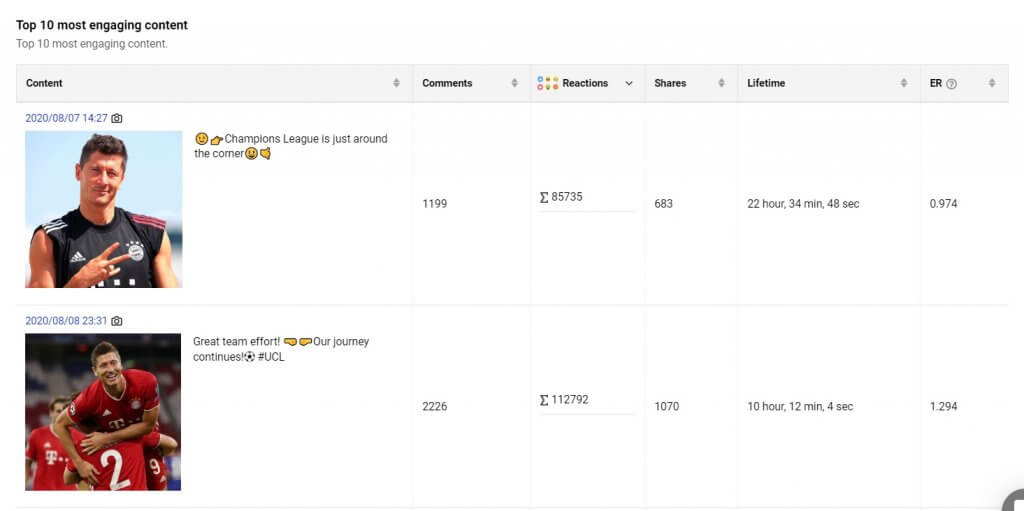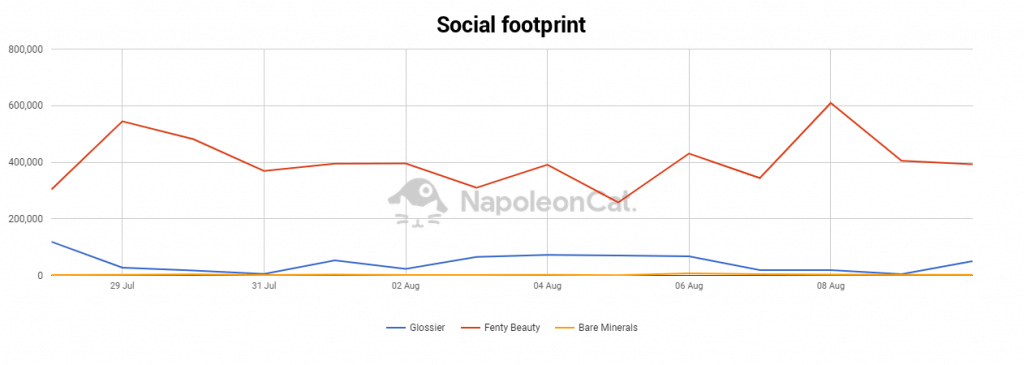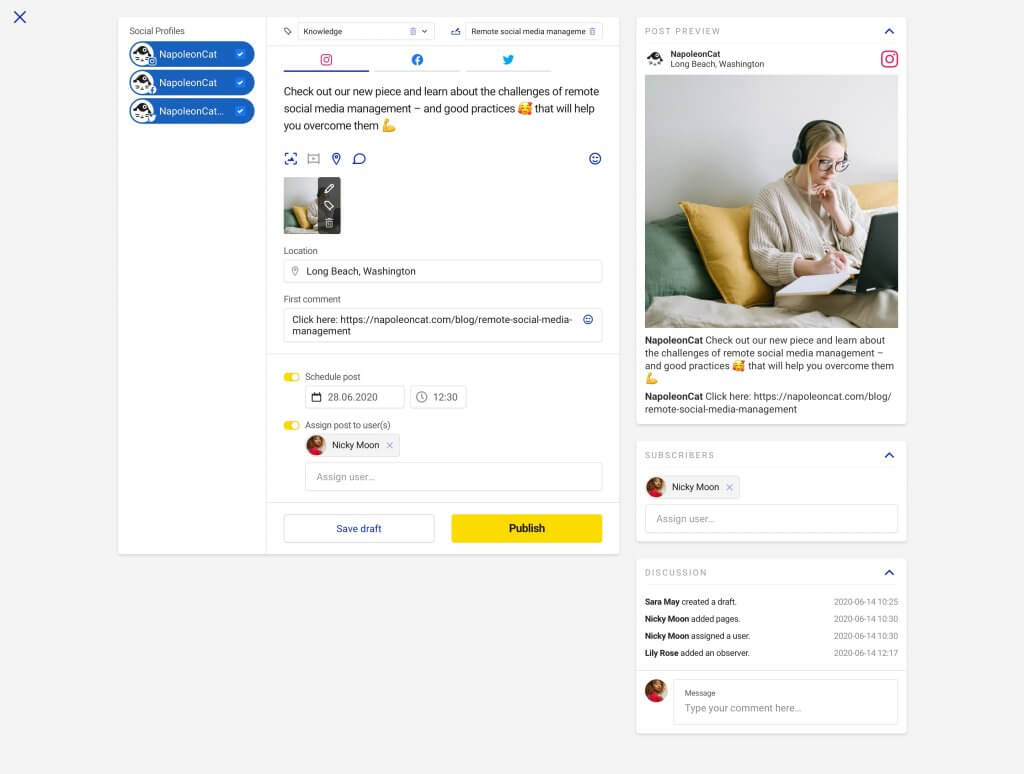Do you need to be active on Facebook in order to achieve success on social media? Not necessarily, but as the most popular of all social media channels, Facebook can definitely help you meet business goals and reach your target audience.
To achieve both of those things you will need the right Facebook content strategy. So, how to create one? Where to look for data and inspiration? Keep reading to find out how to plan a Facebook content strategy step by step.
Facebook content strategy: key elements
Thinking of a Facebook content strategy as nothing more than a posting plan is, quite simply, plain wrong. A proper strategy covers many more areas than just content publication.
We’ve identified a few key elements of every Facebook content strategy:
- research
- strategy
- publishing
- content management
- analytics and optimization
Below, you’ll find a list of actionable steps to help you create a fully functional content plan.
Facebook content strategy: step by step
#1 Research
Evaluate your current efforts
If your brand is already present on Facebook then you should evaluate your performance to date. What type of content brought you the best business results? Is your engagement rate satisfying, or does it rather leave a lot to be desired? There’s a huge amount of data to analyze and process, so waste no time if you want your refreshed Facebook content strategy to be successful.

However, if you’re brand new to Facebook then you probably won’t have much to audit. You can draw some conclusions from other previous marketing efforts, though. These findings may not be 100% relevant to Facebook, but they can still provide some helpful insights.
Define and verify your audience
Who are you trying to engage on social networks? Analyze both your current audience and the audience that you most want to reach.
Creating some desired personas that reflect the types of people whom you’d like to interact with may help you craft the right message and understand your audience’s needs better.
NapoleonCat tip: some insights such as location, age, and gender can be found easily. Others are only available via advanced Audience Insights. These will tell you a lot about your current audience: their interests and behaviours, as well as interactions with your brand. You can access Audience Insights for free through Facebook Ad Manager, even if you’re not running any ads.
Conduct a competitive analysis
Don’t jump blindly into your Facebook content strategy. Verify what your competitors are doing and what kind of content yields them the best results first.
A lot of that data won’t be available at first glance.
Fortunately, there are some tools that offer a competitive analysis feature. NapoleonCat helps you build your own competitive analysis dashboards so that you can make comparisons with your market rivals before you even start drafting a Facebook content strategy.

#2 Strategy
Set up smart goals
You haven’t decided to create a Facebook content strategy without a reason, right? Your marketing plan should go hand-in-hand with some business goals that you aim to meet.
Set up SMART goals for your brand.
- Specific
What are your goals and what do you want to achieve? What are the reasons behind the goals you’ve chosen? Make your goals as specific and precise as possible.
Examples?
– grow sales by 5%
– gain 1,000 new followers in 3 months
– increase engagement rate by 10% - Measurable
Are you sure that your goals are measurable? Do you know how to evaluate the results so that you will know if you’re on track to meet your goals?
There are a few ways to do this:
– add UTM tags to your links if you want to track your website traffic
– check statistics and insights for each social media profile on a regular basis
– measure the impact of social media in Google Analytics
– run a competitive analysis to set benchmarks - Achievable
Can you actually accomplish these goals, or are you rather shooting for the stars? Re-evaluate your resources and combine them with your plans. - Relevant
Are these goals in line with your business aims? Is the timing right, or should you wait with the execution? Sometimes it’s better to adjust your plans slightly instead of failing to achieve them. - Time-bound
Can you distribute your goals between specific periods of time? Will doing so contribute to achieving the main business aim? Are you sure that your team has all of the resources, tasks, information, but mainly time that it needs to reach the target?
Creating simple, attainable, and insightful goals is easier to accomplish with the SMART method. When their execution is accompanied by tools, plans, and teams, achieving goals becomes a straightforward process.
Match your resources with your plans
You’ve planned your Facebook content strategy. All of your goals are set, all actions are arranged, and everything is pretty much good to go. Except…you have no resources to kick your marketing strategy off with.
Before you make some bold plans, ensure that you’re well prepared for putting them into practice. Make sure that you have enough staff, that you use the right tools, and that everyone is on the same wavelength and understands the strategy.
If you don’t have enough resources at your disposal, it is advisable to adjust your plans accordingly. Give yourself some time: plan the next steps towards achieving your goals, but don’t rush anything. Slow and steady wins the race!
#3 Publishing
Create a social brandbook
A social brandbook should become a vital part of every Facebook content strategy. A brandbook is a document in which you should identify and describe in detail the important elements of your online presence. What should it include?
- Tone of voice – how do you speak to your audience? What are the do’s and don’ts here?
- Brand message – what do you communicate and need to cover in your content plan?
- Design details – what are the key visuals, colours, and fonts?
- Copy requirements – which aspects might distinguish your copy from others? E.g. a set of branded hashtags or a specific call to action.
Having such a brandbook in handy is extremely helpful in terms of onboarding, for instance, when new team members need to get a grasp of many projects in a short space of time. A brandbook will always be a point of reference too, so that whenever in doubt you can head to this document to verify your ideas or conclusions.
It doesn’t have to be 100 pages long: even a few pages are better than nothing.
Design content lines
Your content strategy should consist of various ideas that you can use to engage your Facebook audience. By preparing a few content lines, your target group can get used to your communication and know when to expect the next pieces of content. However, even if your current strategy already works well, don’t be afraid of shuffling your content and implementing new ideas. You never know when you might really hit the jackpot!
Below, you’ll find a brief list of content types that you can publish across your Facebook profiles:
- Photos
- Videos
- Live / Watch party
- Facebook Stories
- Carousels
- Contests
- Polls
- Infographics
- Reaction voting battles
- Discounts and special offers (including gift card purchases)
- Tips and tricks (relevant to your products, services, or industry in general)
- Blog posts
- Corporate culture posts
- The-human-face-of-your-business posts
- Trending topics (when your brand jumps on the bandwagon)
- Questions
- 360 posts
- UGC (user-generated content) posts
Depending on your needs, you can check out all of these types of posts in your Facebook content strategy, redistribute them evenly across your profiles, or just pick a few of them to start with. Some of them are more likely to be used in specific industries. For example, videos may suit beauty brands well, 360 posts may work wonders in the travel industry, and watch parties may bring the best results for any sector that is particularly involved in e.g. leading webinars.

Don’t get distracted by too many content lines at once, though. It’s better to focus on a few lines first and test them out properly in order to identify the best performing ones.
Set up Facebook scheduling
Marketers often tend to avoid scheduling in their Facebook content strategy, thinking that planning content ahead may damage reach and engagement rates.
We were over the moon to bust this social media myth in our article.
The truth is, that scheduling social media content saves a lot of time, resources, and hassle. Scheduling helps you automate your posting calendar and take care of your regular posting strategy (which may be difficult to manage manually), so that you and your team can focus on more creative tasks.
Using a social media management tool, instead of just the native options provided by Facebook, gives you access to even more features to boost your Facebook content strategy.
There are many social media management tools that you can use for this purpose, but it should come as no surprise that we recommend NapoleonCat.

How can NapoleonCat’s Social Media Publisher help with a Facebook content strategy?
- Automate your publishing: schedule your Facebook posts for publication at any time of your convenience.
- Add specific elements to your Facebook posts, such as UTM tags, links, and images.
- Use several options for collaboration: e.g. internal titles and discussions, subscribers and assignees, content labels, and access levels.

Streamline Facebook publishing
Craft, schedule, and automatically publish content to your Facebook account. Reach your audience when they’re online – not you.
Try NapoleonCat free for 14 days. No credit card required.
#4 Content management
Drive content engagement
A Facebook content strategy should include some community management tactics too. Just publishing your posts isn’t enough: they need to encourage engagement that is steered further by your brand. Don’t leave a single comment unanswered, as you may miss out on building some relationships with potentially loyal clients.
Make sure that you hop onto any interactions. If you share content that is attractive but it doesn’t ignite engagement, then your results may not be satisfying.
Encourage employee advocacy
You may also consider involving your employees in sharing your brand’s content. You shouldn’t push their boundaries though: make sure that they feel comfortable with spreading the word about your brand. If they are willing to share posts, it may increase the content’s reach and improve your employer branding.
#5 Analytics and optimization
Identify bottlenecks
Without evaluating the effectiveness of your posting plan, it may be impossible to identify what delivers and what doesn’t. Diving into analytics can help you identify bottlenecks in your strategy. You can then either resolve or remove them, but one thing is for sure – you wouldn’t be able to do this without checking out the stats. Guesswork is certainly no longer a strategy in 2020, if it ever was!
Recognize the “shining stars” in your Facebook content strategy
The same story goes for identifying those elements that work well for your performance. While spotting positive aspects might be easier than finding mistakes, sometimes you can be biased as for whether it’s really a “shining star” of your strategy or not.
Introduce extra activities
Facebook doesn’t just revolve around Facebook Pages. You may want to give Facebook Groups or chatbots a go too. They can support engagement and help you to reach your audience in other areas of Facebook. Some potential clients may spot your content in a few groups and then head to your Page to stay with your brand for more, and for longer.
Done is better than perfect
Each and every brand had to start somewhere. If you don’t have the time or resources to execute the best social media strategy in the World, you shouldn’t just give up! Create a few simple steps and tactics to follow and implement them in your marketing activities. Having something is always better than having nothing. Good luck!





